![]() Add To Cart This Word Template
Add To Cart This Word Template
 Add To Cart Proposal Pack Ranching #2
Add To Cart Proposal Pack Ranching #2
 Add To Cart Proposal Kit Professional Bundle
Add To Cart Proposal Kit Professional Bundle


Key Takeaways
- One-time License, No Subscriptions: Pay once and use Proposal Kit forever with an up-front price lower than monthly services over time.
- Best Template Flexibility: Start with a proven Ranching Educational Grant Funding Sample Proposal and customize every section, logo, and color to fit your brand and project scope.
- Instant Access: Download immediately and open the sample proposal right away with no waiting, no onboarding delay.
- Ready-Made Structure: See a complete, real-world example (executive summary, scope, schedule, budget, and more) you can mirror for your project. Get a Proposal Pack or Professional package and use the AI Writer to create custom tailored samples or complete first drafts.
- Fully Editable Documents: Replace text, sections, and branding in minutes - no special software skills required.
- Step-by-Step Help: The Proposal Pack Wizard training mode, documentation, and videos guide you through customizing every section so you do not get stuck.
- Built-In Pricing and Quotes: Automate line-item quotes, totals, and taxes from a database, and insert tables/charts so your pricing is clear and consistent.
- Clear Pricing and Bundles: Choose a single industry pack or the Professional bundle for straightforward options that keep costs predictable as your needs grow.
How to write your Ranching Educational Grant Funding Proposal
You can create your customized editable variation of this document using Proposal Kit. Follow these steps to get started.
 DOWNLOADABLE, ONE-TIME COST, NO SUBSCRIPTION FEES
DOWNLOADABLE, ONE-TIME COST, NO SUBSCRIPTION FEES
Proposal Pack includes everything you need to get started now
- This sample proposal plus
- Library of all 200 samples
- Library of editable templates
- All templates in this design
- Basic contracts and invoices
- Financial calculators
- Wizard proposal software
- How to Write a Proposal e-books
- Customize with your logo
Screenshots of 4 of 14 pages of this sample
Click the PDF View link above to see more. The complete sample is included in every Proposal Pack and the included Wizard software can build you an editable version in Word that will be in the design theme you purchased. You can purchase a different design theme than the sample is illustrated with.
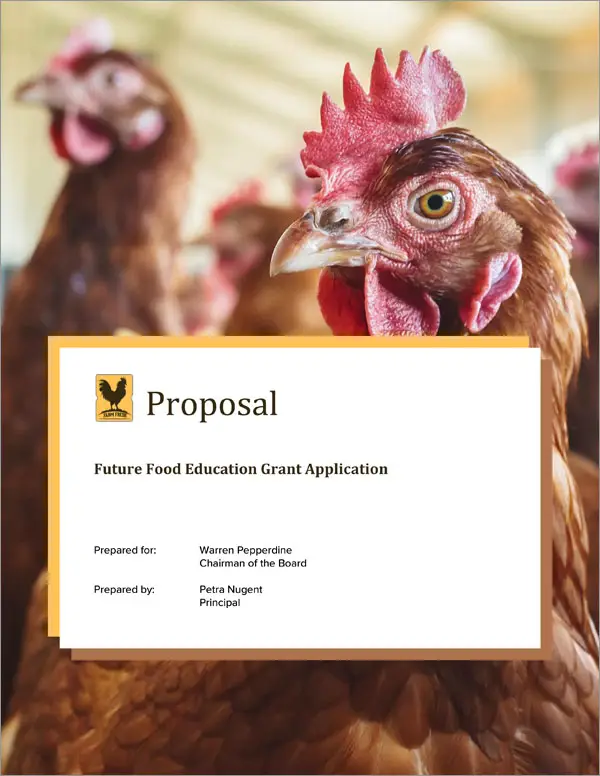
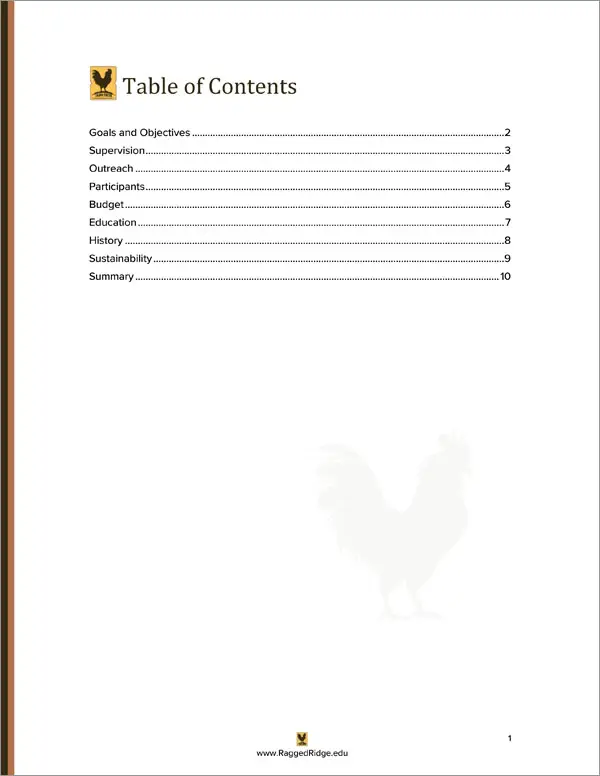
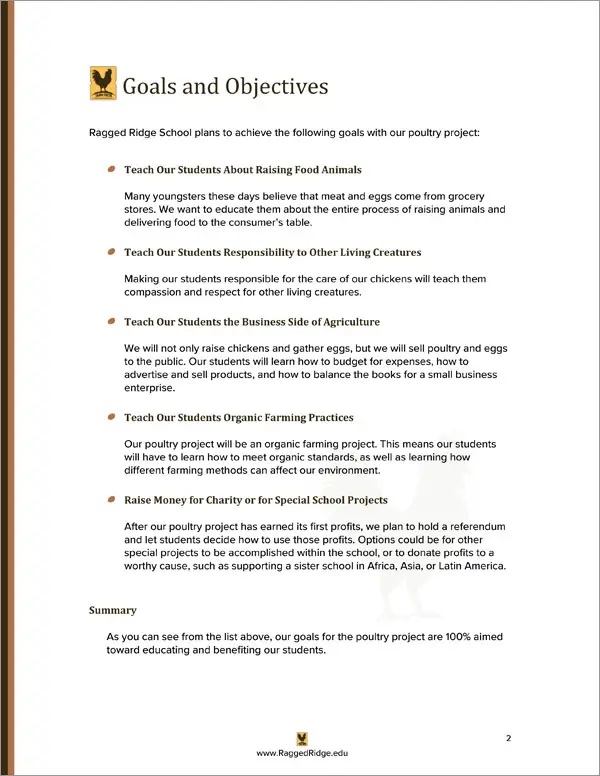
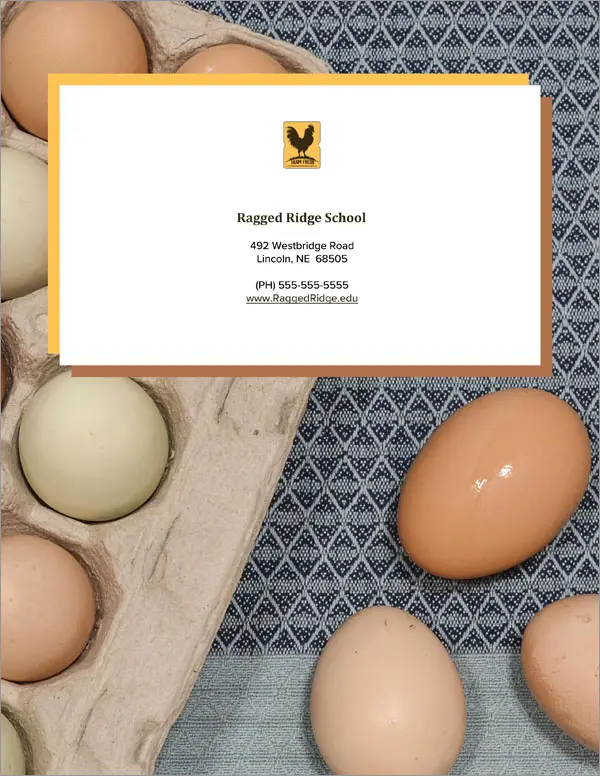
1. Get a Proposal Pack such as Ranching #2
This sample was created using the design theme Proposal Pack Ranching #2. You can recreate this same sample using any of our Proposal Pack design themes and have it customized for your business.
We include this sample in PDF and editable Word format chapters that can be customized using the included Wizard software when purchased with a Proposal Pack or the Professional Bundle.
To create your customized proposal using your logo and colors, get Proposal Pack for Any Business. We include this sample in every Proposal Pack.
2. Download and install after ordering
Once you have ordered and downloaded your Proposal Pack you will have all the content you need to get started. If you order the sample as a template you will download the Word document after ordering and edit it in your office software.
3. Set up the included Wizard software
While the Wizard software makes the process more efficient, you can manually assemble your version of this sample using the content provided and just a Word processor. We only include the Wizard software with a Proposal Pack or the Professional Bundle.
4. Import the Quick Start layout titled 'Ranching Educational Grant Funding Sample Proposal'
The included Proposal Pack Wizard software makes creating a customized version of this document speedy and efficient. The sample content is in Word format documents, so you can also use the sample text without using our Wizard software. Using the Wizard software, you can create custom variations of this template and automate your quotes with the line item database.
This is a good example to follow for anyone proposing ranching or educational grant funding projects.
Anyone proposing a ranching grant or educational grant funding proposal.
5. Customize the template with your information
You can customize the layout with different chapters, change the order of chapters, import your content and information, change the visual design, edit the text, and more. You have complete control over customizing this sample. Use the Wizard's AI Writer to create personalized content specific to your business and project that can be merged with the sample.
Once finished, the AI Writer's Word-to-PowerPoint converter can transform your proposal, business plan, or other business documents into a PowerPoint slideshow.
Abstract
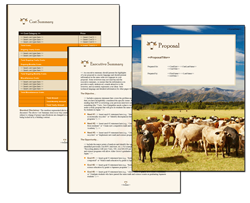
This presents a comprehensive approach to developing a ranching educational grant proposal, focusing on sustainable agricultural practices, livestock health, and environmental stewardship. The featured sample grant proposal highlights the importance of integrating training programs, workshops, and on-farm research to enhance knowledge sharing and the adoption of sustainable practices among farmers, ranchers, and students. By introducing a curriculum that emphasizes rotational grazing, humane treatment, and biodiversity, the proposal aims to equip individual farmers and students with the skills necessary for long-term viability and economic success. The education projects described foster collaboration between stakeholders, allowing for the exchange of ideas and case studies that address the challenges faced in modern agriculture.
The grant proposal includes a funding request that outlines detailed line-item quoting and logistics, ensuring transparency and clear guidance for stakeholders. By using resources efficiently, the project supports food security, productivity, and the long-term benefits of sustainable agriculture. The expected outcomes include improved operations, enhanced livelihoods, and increased resilience against environmental pressures.
The incorporation of traditional methods alongside innovative initiatives ensures development that benefits individual farmers while delivering environmental benefits such as improved soil health and reduced impact on local ecosystems. The Proposal Kit software discussed on the page streamlines the process of building and customizing proposals, providing tools for document assembly and automating calculations to meet the expectations of funders and other projects. Overall, this page serves as a vital resource for anyone seeking to engage in, implement, or support ranching education and sustainable agriculture initiatives through well-structured and effective grant proposals.
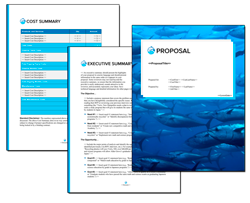
In the broader context of agricultural education and grant funding, this proposal serves as a leading example of how schools and organizations can introduce innovative approaches that are crucial for enhancing both economic viability and environmental stewardship. By prioritizing sustainable agricultural practices and integrating a strong training curriculum, the project not only benefits individual farmers but also strengthens community food security and supports the long-term success of local agricultural operations. The focus on humane treatment of livestock, rotational grazing, and biodiversity reflects a shift toward practices that yield both immediate and lasting environmental benefits.
Proposal Kit s robust features, such as automated line item quoting and an extensive content library, enable users to efficiently tailor each grant proposal to the unique needs of stakeholders. This streamlines the process for educators, ranchers, and other project leaders, making it easier to meet funding requirements while ensuring high standards of project development. The ability to customize and automate proposal creation is especially valuable for those balancing multiple initiatives and seeking to maximize resource allocation for long-term benefits.
For the target audience - including educators, farmers, and non-profit organizations - this approach not only introduces vital knowledge and skills but also fosters an environment where collaboration and innovation can thrive. By engaging participants in real-world agricultural operations and asking them to conduct case studies and on-farm research, the proposal lays the foundation for resilience in the face of future agricultural challenges. Ultimately, such initiatives are crucial to enhancing the capabilities of current and future generations, ensuring that sustainable agriculture remains a viable and rewarding path.

This approach addresses the shifting landscape of agriculture, where traditional methods must adapt to modern expectations for sustainability and economic viability. The inclusion of comprehensive education projects that span biology, business, and ecology ensures that participants not only develop technical skills but also an understanding of the interconnectedness between agriculture, economics, and the environment. By actively involving youth and the broader community, the proposal contributes to building a pipeline of future leaders committed to environmental stewardship and responsible resource management.
Engagement with stakeholders - from students and educators to local community members - demonstrates the importance of collective effort in overcoming challenges such as limited resources, changing market demands, and environmental pressures. The deliberate outreach to neighbors and creation of support networks establishes a foundation for ongoing collaboration and knowledge sharing, strengthening the social fabric around agricultural initiatives.
The project s on-farm research and documentation of case studies create a living laboratory for innovation, allowing for the assessment of expected outcomes and providing guidance for other projects seeking long-term viability. Regular evaluation and reporting cycles not only uphold accountability but also encourage continuous improvement and adaptation, which are vital for sustaining momentum and achieving long-term success.

By using technology and best practices, the proposal exemplifies how thoughtful planning and implementation can lead to lasting improvements in productivity, livelihoods, and overall resilience. The model outlined in the proposal is adaptable, making it a valuable reference for other schools, non-profits, and agricultural organizations aiming to enhance their operations, introduce new sustainable practices, and secure crucial funding for development initiatives.
Ranching Educational Grant Funding Sample Proposal - The Narrative
Future Food Education Grant Application
Please find enclosed our proposal in application for a $10,000.00 Future Food Education Grant. At Ragged Ridge School, our mission is to prepare our students to live in harmony with other people as well as with the environment. While we give our 520 students grades 7-12 a well-rounded education, we place special emphasis on examination of how the world works scientifically and economically.
We pride ourselves on raising future leaders in the fields of science and business. With this mission in mind, we’re sure you will agree that funding our school project to raise and sell organic chickens and eggs matches your organization’s goals of helping a broad audience understand agricultural practices. We’ve tried to provide all the information you may need in this proposal, but we would be happy to answer any further questions you may have.
We look forward to hearing from you soon and to beginning our exciting new agriculture project at Ragged Ridge School this coming spring. Ragged Ridge School is applying for a $10,000 Future Food Education Grant. Your grant will enable us to create both an educational experience for our students as well as a sustainable source of income for our school. Ragged Ridge School plans to achieve the following goals with our poultry project.
Teach Our Students About Raising Food Animals Many youngsters these days believe that meat and eggs come from grocery stores. We want to educate them about the entire process of raising animals and delivering food to the consumer’s table. Teach Our Students Responsibility to Other Living Creatures Making our students responsible for the care of our chickens will teach them compassion and respect for other living creatures.
Teach Our Students the Business Side of Agriculture We will not only raise chickens and gather eggs, but we will sell poultry and eggs to the public. Our students will learn how to budget for expenses, how to advertise and sell products, and how to balance the books for a small business enterprise. Teach Our Students Organic Farming Practices Our poultry project will be an organic farming project. This means our students will have to learn how to meet organic standards, as well as learning how different farming methods can affect our environment.
Raise Money for Charity or for Special School Projects After our poultry project has earned its first profits, we plan to hold a referendum and let students decide how to use those profits. Options could be for other special projects to be accomplished within the school, or to donate profits to a worthy cause, such as supporting a sister school in Africa, Asia, or Latin America. As you can see from the list above, our goals for the poultry project are 100% aimed toward educating and benefiting our students.
Although we want our students to run our poultry project, of course they will need to be taught what to do, and the project will need to be closely supervised to be sure both students and animals fare well and that the project achieves its goals. Please see the Education page for details about what and how we plan to teach our student volunteers. To ensure proper supervision of the project, we plan to do the following.
Appoint a committee of three faculty supervisors each quarter to oversee the project. This will be a rotating duty overseen by the school principal. We hope that faculty members will volunteer for this interesting duty, but the principal is prepared to appoint members if needed. The first quarter will be the most time-consuming, as we will all be learning how to run a poultry business, and one of the duties of the first committee will be to create an instruction booklet for all following committees.
Check the poultry area at least two times per day. A faculty supervisor will check the poultry area at least twice a day to be sure that students are carrying out tasks as expected. Hold weekly meetings during the quarter with team members. A faculty supervisor will hold a weekly meeting with the student team members to make sure everything is going smoothly and resolve any problems.
Provide status reports to the principal on the project. Each month the supervisory committee will report on the status and successes or failures of our poultry project. Ragged Ridge School has already done preliminary community outreach to ensure the support of our neighbors for our poultry project.
Goals
We had two goals in mind when reaching out to our neighbors. Inform them that we may be keeping hens no roosters at Ragged Ridge School. This was especially important for our closest neighbors, as they may hear clucking and other normal chicken sounds.
Gather the names of any neighbors who are interested in purchasing fresh organic chicken and or eggs from our project.
Outreach Efforts
We sent 247 letters to all neighbors who live within a five-mile radius of our school. We received 189 replies via email and regular mail. These consisted of 185 expressions of support, 6 expressions of concerns 3 about the potential to spread viruses, 1 about possible attraction of predators like coyotes, 2 vegetarian issues , and 139 potential customers who were interested in purchasing eggs when they became available.
We responded to those who expressed concerns and created a mailing list of those who were interested in our products.
Benefits
By contacting neighbors in advance of the project, we ensured that we have enlisted community support and that we have a customer base for future sales. Although we plan to educate all students about our poultry project and use examples from our project whenever feasible to demonstrate scientific, math, or economic principles, every student at Ragged Ridge cannot participate in the daily tasks of our poultry project. This means that we must have a method of selecting students for participation.
We anticipate great demand for participation among students. Therefore, we propose to select 30 students each quarter to care for our chickens and collect eggs and actively sell our products. We will develop a list of job titles and descriptions, and select one student to fill each slot at the beginning of every quarter, based on the following criteria.
Desire to Participate The student must apply for a particular position in writing, stating why he or she is qualified to do that job and what he or she expects to gain from the experience. Availability Dependability Different jobs within the project will demand specific time commitments. Applicants must be available to carry out the tasks when needed.
Overall Academic Record Applicants must have demonstrated their ability to carry out their normal school activities and assignments with satisfactory grades. We don’t want academic studies to suffer as a result of taking on extra tasks in our poultry project. Random Drawing Names of qualified applicants will be placed into a pool at the beginning of each quarter, and one name will be drawn at random to fill each of the 30 positions. We anticipate having an enthusiastic group of participants of varying ages and dispositions each quarter.
Students will learn to work together to make decisions and maintain schedules. We anticipate the following costs for the project for our first year. Note that all costs are estimated and will change somewhat due to changing prices and start time for the project.
- Materials for chicken coop associated structures, and fenced enclosure
- Expert construction assistance optional
- Chicks 50 hen chicks up, 1 day to six weeks old, $3 chick
- Organic chicken feed – Avg of $.10 day per hen 50 hens 365 days
- Electricity to warm chicken coop and light structures – Avg $1 per day 365
- Water for chickens – Avg $.01 day per hen 50 hens 365 days
- Egg cartons 500
- Tools
As you can see, we project that our costs will come in at slightly less funding needed than the $10,000 grant, but these are all estimated costs. Depending on weather and health of our chicks, we may need to pay for extra heat or cooling or replacement animals. During the last half of the first year, we hope to be bringing in money from egg sales.
We envision our poultry project as a real-world learning experience for our students, as well as a money-making venture. Here’s a brief summary of how we will use our plan to raise chickens and sell eggs for education purposes. Biology We will use our chickens as examples when examining the topics of genetics, digestion, biochemistry, anatomy, and reproduction.
Ecology Environment We will use our poultry project as an example to study the issues of food supply, species survival, pollution, and sustainability. Business To organize and run our poultry project and egg-selling business, we must teach the business principles of supply and demand, profit and loss, marketing, advertising, planning, scheduling, and general accounting and reporting practices. At Ragged Ridge School, we pride ourselves on raising future leaders in science and business. This project will promote both fields and give students practical experience that will benefit them in the future.
Ragged Ridge School is a private middle and high school focused on science, economics, and global awareness. Our campus sprawls across 25 acres outside of Claremont, New Hampshire. Ragged Ridge School was first established in 1972 as a small college preparatory academy for 270 international students, mostly the children of diplomats serving at the United Nations, with an emphasis on international history, politics, and languages.
In 1995, the school expanded its facilities and its mission to include 520 students of various economic and social classes, and broadened its focus to emphasize science and economics as well as international issues. Any student in grades 7-12 is welcome to apply to attend Ragged Ridge School. Our student selections are made based on academic goals, previous performance, and our interest in maintaining a diverse student population.
Our students range in age from 12-19, and originate from across the United States as well as from many foreign countries. Forty percent of our students attend on scholarship. The project has been designed to be sustainable beyond the initial funding period. Although we do not plan to keep roosters because of their combative dispositions as well as their crowing and potential noise complaints from neighbors, we plan to borrow a rooster from time to time to create new chicks and replenish our flock as older hens stop laying eggs and are sold.
Surplus rooster chicks will also be sold. Assuming that our organic egg business is as successful as we predict it will be, our poultry and egg project will continue for as long as the school wishes to participate. We hope this project will contribute substantial funding for other school projects or for charitable donations. Our school has the real estate available to enlarge the initial poultry project, or to plant food crops and raise other types of livestock to further our investment in agricultural studies.
Our plan for sustainability fits in perfectly with the mission of the Future Foods Center. Following are the steps we envision for our poultry project. Note that students will participate in each step.
Design our poultry area. After studying typical designs and guidelines for chicken coops and outdoor chicken enclosures, a committee of students and teachers will create a blueprint, calculate materials needed, order supplies and gather tools, and schedule all the work necessary to construct a chicken coop, enclosure, and associated processing and storage areas. Construct our poultry area. After having an expert check our plans and make any needed revisions, students, teachers, and volunteers will build our chicken coop, enclosure, and other structures.
If we lack a volunteer with sufficient construction experience, we may need to hire a qualified carpenter to help oversee this step of the project, which could take several days or weeks, depending on weather and availability of personnel involved. Acquire 50 hen chicks of varying breeds as well as all needed supplies. We plan to do research on breeds of chickens and purchase chicks from 3-4 breeds known for their egg laying and other market qualities.
At this time we will naturally also purchase the chicken feed and other supplies we need to get started. Raise chicks to laying age. According to our research, chicks are generally considered delicate up to 6-7 weeks of age, and should be kept indoors or in a protected, temperature-regulated environment. Hens begin laying eggs at 18-22 weeks.
Students will feed and water chickens every day, as well as keeping the enclosure clean and keeping notes on progress of growth and general health. During this time period, we will also plan our egg collection schedule and our packaging, sales, and distribution strategies. Collect, package, and sell eggs, and butcher and sell chickens.
After egg-laying begins, we will put into practice our strategies for collecting and selling our eggs. When hens fail to lay eggs, we may decide to butcher and sell them. Develop our business strategies and methodology and make changes as needed.
Students will track sales and expenses, keep the accounts current, and propose and develop marketing strategies for our poultry and egg business. Determine how to spend our profits. When we have reached profitability, our student body will help us determine how to spend our profits, choosing between using monies for special educational projects at Ragged Ridge School or making donations to charity. As you can see, we intend for our poultry project to be an ongoing educational opportunity for our students to learn agriculture and business practices.
 What Our Clients Say
What Our Clients SayA simple software tool to meet complex "Request for Proposal" requirements. I’ve used this on a few proposals, and haven’t found an easier solution."
ISC Services LLC
There are 200 complete sample proposals including this one in each Proposal Pack
The following related samples are also included in Proposal Pack:
These template layouts are related to this sample
The following related templates are also included in Proposal Pack with this sample:
- Agricultural Grant Funding Proposal
- Educational Grant Proposal #2
- Agriculture and Ranching Grant Funding Proposal
- Educational Grant Proposal
- Grant Funding Request Proposal
- STEM Educational Program Proposal
- Vocational Job Training for Youth Proposal
- Vocational Education Proposal
- Training for Skills Development Proposal
- Retraining Workers Skills Development Proposal
Length of Sample
14 PagesThere are thousands of chapters to choose from in Proposal Pack. This sample uses the following set of Proposal Pack chapter templates: Cover Letter, Title Page, Table of Contents, Goals and Objectives, Supervision, Outreach, Participants, Budget, Summary, Education, History, Sustainability, Back Page.
Ranching Educational Grant Funding Sample Proposal Calculator Spreadheets
These Excel calculator spreadsheets are included with this template. If you purchase a Proposal Pack or the Professional Bundle, these proposal pages are generated using an automated line-item database in the included Wizard software. The calculator spreadsheets are intended for use when purchasing only the sample as a static Word template.
This sample illustrates how to write the following types of proposals
- Education, training proposal
- Non-technical proposal
- Project pitch proposal
- Non-government grant, non-profit, NGO proposal
- Student project proposal
- Spiritual, church, community proposal
- Food, beverage, catering, grocery proposal
- Ranching proposal
- Many other types of proposals
Samples can be created in any Proposal Pack design theme
This sample was created with Proposal Pack Ranching #2. To change the visual look purchase any Proposal Pack and this sample will be created in that design theme.
Out of the over 501 Proposal Packs available these designs are also popular for this type of proposal and this sample proposal is also included in every Proposal Pack:
Photo Design Proposal Packs
 Proposal Pack Ranching #1
Proposal Pack Ranching #1 Proposal Pack Ranching #3
Proposal Pack Ranching #3Line Art Design Proposal Packs
 Proposal Pack Contemporary #14
Proposal Pack Contemporary #14 Proposal Pack People #2
Proposal Pack People #2 Proposal Pack People #3
Proposal Pack People #320% Off Discount
![]() Add To Cart This Word Template
Add To Cart This Word Template
 Add To Cart Proposal Pack Ranching #2
Add To Cart Proposal Pack Ranching #2
 Add To Cart Proposal Kit Professional Bundle
Add To Cart Proposal Kit Professional Bundle
 4.7 stars, based on 849 reviews
4.7 stars, based on 849 reviewsFrequently Asked Questions
How do I customize this sample to fit my specific project or business?
If you purchase this sample as a static template, it will be an editable Word format document; otherwise, if you buy a Proposal Pack or the Professional bundle, you can build a more customized editable Word document version of it using the included Wizard software. You can replace the sample information with your own, adjust the text to match your company's tone and style, and modify sections to include project-specific details. The included AI Writer will also customize the content for you.
Can I use multiple sample proposals for different types of projects?
You can purchase multiple samples as individual Word templates or all 200 samples are included in every Proposal Pack and Proposal Kit Professional, which is a much better deal. The Proposal Kit offers sample proposals for various industries and project types. You can select and customize different sample proposals to suit each unique project. This flexibility allows you to create tailored proposals for other clients or projects.
How can I integrate my branding into this sample?
While this sample is an editable Word document, depending on the level of custom branding needed, consider the Proposal Kit Professional, which includes the branding features in the Wizard software that let you create custom-branded design themes more effectively. Start by incorporating your company's logo on the cover page, as well as in the headers and footers of the document. Next, adjust the color scheme of the proposal to match your brand colors. Change the fonts in the proposal to align with your brand's standard fonts. Including branded graphics that reflect your brand's style will further enhance the proposal. Additionally, ensure that the text within the proposal maintains a tone and voice consistent with your brand's communication style. By integrating these elements, your proposal will reinforce your brand identity.
How do I ensure my proposal stands out and wins the client?
To ensure your proposal stands out:
- Personalize the content: Address the client's needs, challenges, and goals to make the proposal unique.
- Highlight your value proposition: Communicate what sets your business apart and how to deliver superior results.
- Use professional design elements: Incorporate visuals, charts, and graphs to enhance the presentation and make it more engaging.
- Proofread and edit: Ensure the proposal is error-free and well-organized. A polished, professional document reflects your attention to detail and professionalism.
What should I do if I need help understanding or modifying a section of this sample?
If you need help understanding or modifying a section of this sample, refer to the detailed instructions provided. Additionally, Proposal Kit includes customer support and resources such as tutorials and videos to assist you. Consulting with a colleague or a professional in your industry can also be beneficial if further clarification is needed. Asking an AI tool can also provide valuable insights for immediate needs. You can load this sample into the Wizard software and let its AI Writer customize the pages for you.
 Ian Lauder has been helping businesses write their proposals and contracts for two decades. Ian is the owner and founder of Proposal Kit, one of the original sources of business proposal and contract software products started in 1997.
Ian Lauder has been helping businesses write their proposals and contracts for two decades. Ian is the owner and founder of Proposal Kit, one of the original sources of business proposal and contract software products started in 1997.By Ian Lauder
 Published by Proposal Kit, Inc.
Published by Proposal Kit, Inc.


 Cart
Cart
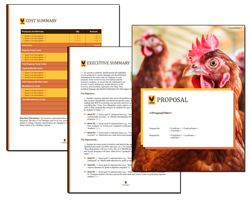

 Facebook
Facebook YouTube
YouTube Bluesky
Bluesky Search Site
Search Site